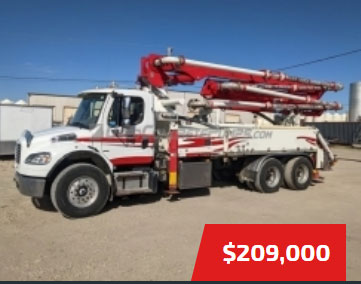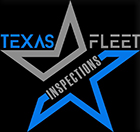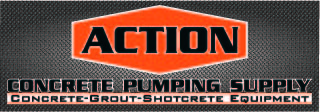| greenguy | 11-24-2009 | comment profile send pm notify |
|
So I thought I'd post a message about the "no metal on your tip hose" safety campaign. Today, just like a day or two of every other week, I had a customer ask for a double 4" -90 degree bend at the end of the tip hose. He said that every other pump company that he uses does it, and thinks that all other tip hoses make too much splatter. Its been nearly 10 years since we have hung anything but a rubber ended hose off the end of any boom that we own. We've been using reducing hoses and our own version of what looks like a mud snake for this entire time without a single injury resulting from a hose whip (and there have been hose whips - maybe 1 or 2 a year). So my question is - who are the pros that we're talking about? The three largest pump companies in the Southern and Central Ontario area hang all sorts of steel off the end of their hoses on a daily basis (if you pump in this area you'll know who they are). In fact, I'd have a tough time finding anything more than 5% of the pumps in this area that follow the "Pump it like the pros - no metal on your tip hose" practice 100% of the time (although I hope they exist and I just haven't encountered them). There are several hundred pumps in the region that we compete in. If all of these ACPA member companies fail to heed one of the ACPA's most important safety warnings, what's the point of having ACPA trained operators? (I know - this is kind of a pessimistic comment - and there are plenty of other reasons to train operators using ACPA materials). I'm really more frustrated than anything that I lose a customer every now and then to other supposedly "safety concious" companies because we won't hang the wrecking ball off the end our tip hoses. When times were good, we'd just let those customers go elsewhere, but in times like the present, its just not that easy . . . . Any comments or suggestions? |
||
| pumpjockey | 11-24-2009 | reply profile send pm notify |
|
I think these customers should own the hardware below the reducer. Sell them the double-ender, 2 clamps & gaskets, 3 safety slings, and the hardware to build the double 90. Make them attach it. And have them sign a waiver after they read all pertinent safety information and the videos on the subject, as well as any fatality and injury investigation reports relating to hose-whipping. Oh, and have the crew boss stand in for the lowly hoseman. Oh, damn, I forgot we're not in a perfect world....but that's the way it should be. |
||
| Pump N00b | 11-24-2009 | reply profile send pm notify |
|
They make YOU take courses on HSE before YOU are allowed on their site, they make YOU sign the papers that YOU are gonna follow their HSE protocols, they make YOU wear the proper personal safety gear like hard hats, vest, shoes etc. and so and so. |
||
| bluefx4flare | 11-24-2009 | reply profile send pm notify |
|
Many times its not the customer requesting it, its that one worker who is the designated hose man who doesn't want to get dirty.
I am from the Toronto area and work in the Low rise sector so I know where you're coming from.
As of right now I am working up in Ottawa, and how they set-up here scares me.
From the end of the boom there's a 5-4 reducer than a double ended 4" hose than a 4-3 reducer with handles welded on for the hose-man to control it with.
all pumps from this company bring and assemble this contraption every-time.
The mud up here is better than the GTA. More powder and sand in the mix with 1/2" course gravel which pumps very easy, hence why there haven't had any problems with these contraptions.
When I was the hose-man last week, I could see the hose stretching under the weight of the mud because it could not exit out of the 3" hole fast enough and back up. It would jitter up and down quickly till it cleared itself. I promptly removed it. My other guys like using it even after I told them the dangers of it. I even tell the operators of this company how dangerous it is, but they thought I would be pleased that that they have them available for us to use. Go figure.
There's worse out there than just a double-ender. |
||
| greenguy | 11-25-2009 | reply profile send pm notify |
|
Does anyone know of any actual cases where a guy was hurt by a tip hose attachment? If I can get evidence of atleast a case or two (location and some details of an incident), I can make up a flyer that includes the ACPA double 90 warning ad along with a couple of "case profiles". Then I can laminate it and send them out with the pumps for the customer to read before they complain too much about our reducing hoses. I'm not a big fan of regulations and rules, but requirements in Ontario are currently very lax: -no licence plates (considered "road building equipment" by the ministry of tranportation, and are therefore unplated) -no mandatory daily circle check or log book - no annual mandatory truck inspection -no mandatory boom inspections -no mandatory operator training - just a straight truck license -no restrictions on tip hose attachements I'm worried to think that when the relatively new fleet of concrete pumps in Ontario begins to age past the 5 year old point (which will happen in the next year or two), some of those small cracks are going to start to appear in a catastrophic fashion if they don't get noticed before hand.
|
||
| pumpjockey | 11-25-2009 | reply profile send pm notify |
|
The 'boom' in aging concrete pump booms is going to show up everywhere.
The designs of modern booms is such that there are few 25 - 30 year machines out there anymore. the ones from the good old' day could be re-trucked and carry on. Now, they will also need to be re-boomed. and more attention paid to the chassis structure too.
As the booms got longer, the physical structures were made out of lighter steel, with presumably better engineering design and materials. But at some point with fatigue, they will be past the point of serviceability.
Australia has some extreme regulations regarding their pump inspections, but it serves a purpose. No doubt there are pumps in the land down under that are not inspected either, and should not be in service by any standards. |
||
| Todd Jr | 11-26-2009 | reply profile send pm notify |
|
Good news guys! The CSA standard for concrete pumps in Canada, which we have been working on for the past few years is now finalized. The new standard is Z151-09 – Concrete Pumps and Placing Booms. It covers all of these issues, including operation, maintenance and inspection. |
||
| Boom Inspector | 11-27-2009 | reply profile send pm notify |
|
Hey Todd Jr, do you have a link to that standard yet ? I tried to google it and no luck |
||
| Todd Jr | 11-27-2009 | reply profile send pm notify |
|
I have a complimentary copy that I was given for serving on the technical committee. I also asked if I can share it with others in our industry and was told that distribution is prohibited, but copies can be purchased through the CSA Sales Department, sales@csa.ca I am not sure what the cost is. If anyone has any specific questions I would be happy to answer. |
||
| Granddad | 11-27-2009 | reply profile send pm notify |
|
Having worked over the years for two of the big 3 in Ontario I do know that by law a daily pre trip must be filled out and in the machine. Pre trips must be filed for a minimum 3 months I beleive, in case a machine is involved in an accident. You are correct about annual safety inspections. However that does not mean you can run an unsafe machine on the highway. Correct me if I'm wrong todd Jr. but years ago did we not carry ownerships that stated fit unplated and needed the yellow sticker? I also know that the blue and the red also have a staff of top notch mechanics to keep their repective fleets in shape. I also know that those two companies are largely responsible for getting mandatory training in place. Also those two companies unlike others in Ontario had a training program in place and you didn't take a machine out until you were trained. I know some of the upstarts have not commited the time, effort and money into training at all. Both of these companies have top notch operators that for the most part share their knowledge and experience with all newcomers. It is what makes for a happy team. The companies that say this industry is easy[put the grey stuff in there and it comes out there] piss me off. You are correct in stating bom inspections must be mandatory. Did you also know that red and blue have staff that have taken the boom inspection courses. That a growing number of I.C.I projects demand a boom inspection report. Perhaps instead of lumping red and blue in with the rest of the world you should thank them for the effort they have put into this industry instead of blaming them. |
||
| Todd Jr | 11-27-2009 | reply profile send pm notify |
|
That was very well put Granddad! Companies that think this industry is easy and run by the seat of their pants in Canada are in for a big surprise with this new CSA Standard. The reason we have moved forward with this is because of too many accidents with the pumpers who think this industry is a breeze and do not act responsibly. We look at operating our units without license plates as a privilege that's why we follow every regulation as if we do have plates. How could you live with yourself if hurt someone with a vehicle that you know is unsafe to operate. If you think you can get away with it with the Ministry of Transport just remember you also have the Ministry of Labour. |
||
| greenguy | 11-30-2009 | reply profile send pm notify |
|
I wasn't indicating that the "blue" and "red" run unsafe equipment or don't practice due diligence when it comes to equipment safety. I don't doubt that their equipment is better serviced in in better condition than many or most of the smaller companies floating around. I was simply pointing out that if the biggest and most experienced companies in Ontario don't practice the "pump it like the pros, no metal on your tip hose" philosophy, then where are all the professionals that are mentioned in the first part of this statement? The reason that I pointed out the lack of requirements is to demonstrate what you can get away with if you wanted to (although you certainly shouldn't). We complete against companies without current boom inspections, operating trucks that haven't seen the hand of a licensed mechanic for years. And if you don't get caught, and don't hurt or kill someone, you get away with it, which is the case most of the time. The ministry of transport simply doesn't have enough people on the road to check every truck, and the ministry of labour has little or no enforcement personel. So if the MTO doesn't ask for a circle check (which they never do), and the MOL doesn't have the people to ask for them, then how would they know if you weren't doing one? |
||
| greenguy | 11-30-2009 | reply profile send pm notify |
|
I just ordered the new CSA Standard Z151-09 - Concrete Pumps and Placing Booms. It is a $75 download from shopcsa.ca. The standard is pretty comprehensive otherwise and is worth the read if you can get your hands on it. I read through it quickly, but cannot find anywhere in this standard any rules or regulations pertaining to tip hoses and what they consist of. The standard simply states that tip attachments should not exceed the manufacturer's maximum recommended weight rating for the boom tip (I'm paraphrasing so as to not infringe on copywrights, otherwise I'd paste the entire section here). There's also the common sense items that tell you not to attach a rigid pipe to the tip elbow without a flexible hose in between them. So even with this new standard, we still only have recommended (ACPA) practices for tip hoses, and nothing mandatory prohibiting double ended tip hoses and double 90's. Todd Jr - if I missed something in the standard that would prove the above statement wrong, please let me know.
|
||
| Granddad | 11-30-2009 | reply profile send pm notify |
|
This still bolis down to education., which is what I was saying about senior/ experienced operators. When everyone started running buffers/rams horns etc. there was a small group who wouldn't. Safety was one point but we all know in res. work bottom line cost is what matters. So instead of playing the safety card we played the efficiency card. If you are doing. half a dozen set ups a day in a subdivision showing the developer you can come in 1/2 hr to an hour faster by not screwing around hooking up and dicconnecting do you think anyone cares what the hose guy says. This will also absolve you of being the operator that nobody wants because you sream safety,safety. Everyone wants a safe jobsite but there are times you have to play mind games to get what you want. If you have ever gotten pulled over in the scales you will know by now that we are not allowed to drive unsafe equipment on the road, those who ar their day is coming. If we all lose the privelege as Todd JR. says of driving unplated and have a safety every year, whose equipment will be on the road and who will be either spending a crapload of money fixing/out of business or on line whining about the big companies who have maintained their fleets with good mechanics and good operators |
||
| Todd Jr | 12-01-2009 | reply profile send pm notify |
|
We started working on the standard about 3 years ago and for the most part mirrored the CPMA standard only making changes that fit better in Canada, such as civil rights and metric. There was never any mention about double ended hoses, etc. from any of the pump manufacturers present at the meetings. The important sections covered in the new standard are inspection, maintenance and testing as well as operation. We have also been working with the Minister of Colleges and Training as well and have so far managed to make concrete pumping a recognized trade in Ontario and will be working further to making it compulsory. There is currently a school set up at Local 793 in Oakville with in school training as well an apprenticeship program similar to mobile cranes. We have come a long way to making our industry safer, but still have a ways to go. If you get a chance stop in at Local 793 hall and see the concrete pump simulator. It is really cool. |
||
| Todd Jr | 12-01-2009 | reply profile send pm notify |
|
Check this out! Concrete-pump simulator offers state-of-the-art training for operating engineers http://dcnonl.com/article/id27619 |
||
| pumpjockey | 12-01-2009 | reply profile send pm notify |
|
OK, how many high-voltage lines, loosely-backfilled trenches, and short-rigging oppotunities are programmed in? Are there any steep, off-angle set-ups? Do the virtual finishers interupt your wash-out and rig-out routine? Do you get unpumpable mud? How about hot mud? Fin-fish? And bleeding, segregating mix? Does the boom drop when priming? Does it suck in air when the virtual mixer driver is talking on his cell and not paying attention to his job, does the hose whip in such a case? Is there boom bounce? Do you get to follow a wall with varying heights? Is the hose-man on the slab stubling over rebar? Do you get to virtually wash out? If not, it's just a videogame masquerading as training.
|
||
| Todd Jr | 12-02-2009 | reply profile send pm notify |
|
That’s why it’s part of a 3 week in school and 2000 hours apprenticeship program. No more 2 or 3 days training by the manufacturer and you’re a pump operator. It’s better than anything else out there today and constantly being updated and improved. |
||
| Todd | 12-02-2009 | reply profile send pm notify |
|
I think the school is a great idea and the video training is just a tool. I am glad they are doing what they can and they are doing a good job from what i hear. Keep it up. |
||
| murf | 12-02-2009 | reply profile send pm notify |
|
2000 hrs???????????? does this apply to all pumps?, surely its not the same for a 16m as for a 52? |
||
| pumpjockey | 12-02-2009 | reply profile send pm notify |
|
Thanks for the further clarification. But even just running the sticks, nothing beats real-world. Real depth perception is far different than anything a computer can give you on a screen, even if it is a fancy curve in front of you. What the simulator should be used for is to teach the technically dangerous aspects of concrete pumping. Have a guy get into virtual wires, set an outrigger over a virtual septic tank, have a thunderstorm come out of nowhere. Have it suck air then plug, and whip, throwing the virtual hoseman to ther dirt. Have the virtual hoseman get clocked by a double 90.... Force a set-up outside of 3 degrees and have the boom runaway on the operator. Scenarios to test the mettle of operators just like those that the military and airlines use to stress out their pilots without risking real equipment. |
||
| Granddad | 12-02-2009 | reply profile send pm notify |
|
I would love to be a fly on the wall the day an operator says to the company owner/ministry of labor or the police "I don't know what happened, I could do it on the simulator at school" You ar correct that real world training beats virtual hands down, however could you imagine the lawsuits for teaching or showing someone how to operate in positions that every company/manufacturer tells us not to. I'm not saying it doesn't happen but the point of the school is to teach safety first. Proper setup/ blocking/priming/setup of pipeline etc. is what they are doing. If you want to include those scenarios then you should have programs that include all manufacturers, black&white proportional world standard north american standard John deere standard etc. Yes the apprenticeship is the same for a 16 or 52 the safety principals are the same. The apprenticeship is the same if its a 17 ton boom truck or 500 ton crane. And to top off all of this the only people taking advantage of this resource are the same people who were involved in getting concrete pumping recongnized and getting the csa standard initiated yet ther are companies out there with operators who don't think they can get hurt by hydro lines!! So I feel that instead of bashing a training tool how about some input on some training ideas. I know the instructors and they are open to any suggestions. |
||
| Todd Jr | 12-02-2009 | reply profile send pm notify |
|
The pump simulator is only as good as the programming which I am sure different scenarios can be added. Your input is great and has given me some good ideas to run with. I have sold the school a new Schwing 32 meter pump with pipeline to assist in the training. They have a good supply of tools to work with. I know the guys who we have sent have said the school is very good. They even got a tour of a ready-mix concrete plant which will help them understand more about concrete. As I have said previously we are learning as well as we teach and things will develop more as more people attend. As Granddad has stated we are hoping after 2000 hours the apprentice will be able to run any size pump. During his apprenticeship he will hopefully be put in a lot of different situations, but I do know from my own experience operating a concrete pump that you never stop learning and that's why I love this industry! |
||
| moose | 12-05-2009 | reply profile send pm notify |
|
This is concrete pumping!! The hose is going to splatter some time or another. You will not always have a full flow out of the end of the hose. The contractors know that!! If it is the guy at the end of the hose complaining about splatter, tell him to put some safety glasses on!!!!!!!!!!!!!
Problem solved.
IT'S NOT ROCKET SCIENCE!!!!!!!! |
||
| Pump N00b | 12-06-2009 | reply profile send pm notify |
|
Bored today at the shop and browsed through the manual of the shitty CIFA pumpmixer I currently run (thank god it's only 5 more days 'till I'm done where I work now!), and found alot of crazy stuff. |
||




















.jpg)
.gif)

.jpg)









.jpg)








